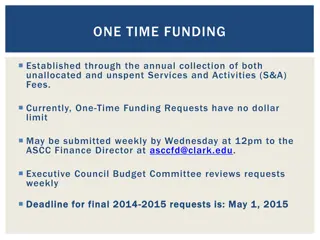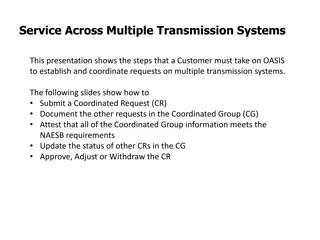
Understanding Asynchronous Data Requests
Learn about how asynchronous data requests work in web applications, the benefits of loading resources asynchronously, and how JavaScript enables this process efficiently. Explore examples of fetching resources asynchronously and how libraries like AsyncRequest and AsyncResponse simplify the process.
Download Presentation

Please find below an Image/Link to download the presentation.
The content on the website is provided AS IS for your information and personal use only. It may not be sold, licensed, or shared on other websites without obtaining consent from the author. If you encounter any issues during the download, it is possible that the publisher has removed the file from their server.
You are allowed to download the files provided on this website for personal or commercial use, subject to the condition that they are used lawfully. All files are the property of their respective owners.
The content on the website is provided AS IS for your information and personal use only. It may not be sold, licensed, or shared on other websites without obtaining consent from the author.
E N D
Presentation Transcript
Asynchronous Requests Jerry Cain CS 106AX November 15, 2024
Asynchronous Data Requests When you load a website, the initial HTML document often references many other resources (images, JavaScript files, CSS stylesheets, and so forth) to be downloaded as well. Some resources images and videos, in particular can be very large. The larger the resources, the longer it takes for the application to load and properly function. Most web applications minimize the amount of data needed for the initial user experience and interaction. By doing so, their website loads more quickly, and the application is operational with minimal lag time, also known as latency. As new resources are needed, the website can download those resources in the background that is, asynchronously. Once the new resources have been downloaded, JavaScript can programmatically update the DOM to incorporate them.
Asynchronous Data Requests The initial resource needed by most web applications is almost always formatted as HTML, which includes data and information about how they should be rendered in the browser. Asynchronous requests, however, generally fetch data as plaintext or JSON format without the surrounding HTML. The new data can be programmatically inserted into the DOM. As with the initial request for the HTML document, asynchronous data requests are framed as URLs, as with: graph.facebook.com/me (Facebook API) api.x.com/1.1/statuses/user_timeline.json (X/Twitter API) numbersapi.com/122 (Toy API providing fun facts about numbers) numbersapi.com/122?json=true (Same API that formats response as JSON) Most servers can infer from the URL itself whether the response should be HTML, plaintext, or JSON.
Asynchronous Data Requests The URL used on the left fetches a plaintext resource with trivia about the number 122 and renders it once it arrives. The URL on the right requests the same resource, formatted as JSON instead of plaintext. In both cases, the browser opens a connection to the relevant server. It then issues a request for the resource associated with the URL, waits for the server to respond, and renders the response s payload once it arrives.
Asynchronous Data Requests Life would be terrific if we had JavaScript functionality to do the same thing a browser can to programmatically request a resource through some URL, wait for a server response, and then process that response to suit the needs to the application. Fortunately, life is terrific!
Asynchronous Data Requests JavaScript provides built-in libraries to help asynchronously fetch resources as they re needed. Unfortunately, they rely on JavaScript features slightly beyond the scope of our syllabus. The CS106AX libraries include two classes that layer over the complexities of those built-ins so we can still asynchronously fetch new resources. Those new classes are called AsyncRequest and AsyncResponse (modeled after libraries used at Meta). let req = AsyncRequest("http://numbersapi.com/538"); req.addParams({json: true}); req.setSuccessHandler(function(response) { console.log(response.getPayload()) }); req.send(); The code above illustrates how these classes can be used to publish some trivia about the number 538 to the console.
AsyncRequest and AsyncResponse Creates a request object primed to fetch a document from url. AsyncRequest(url) Adds a key-value pair to the url s of query string. request.addParam(key, value) Adds all key-values pairs in params to the url s query string. request.addParams(params) Sets the callback to be executed when the server responds. request.setSuccessHandler(callback) Sets the callback to be executed if the server fails to fetch the url. request.setErrorHandler(callback) Initiates the request for the relevant resource. request.send() Returns the payload from the response passed to your callback. response.getPayload()
AsyncResponse and JSON.parse The callbacks passed to request.setSuccessHandler and request.setErrorHandlershould be functions that take a single argument of type AsyncResponse. AsyncResponse exports several methods, but in a success scenario, the only one that matters is getPayload(). If the payload is formatted as a JSON string, then you should pass that string to the built-in JSON.parse function to rehydrate it into a true JavaScript object. let req = AsyncRequest("http://numbersapi.com/222"); req.addParams({json: true}); req.setSuccessHandler(function(response) { let payload = response.getPayload(); let info = JSON.parse(payload); console.log("Trivia: " + info.text); }); req.send();
Exercise: Number Trivia Slideshow Implement a program that generates a random number between 1 and 200 and presents a random piece of trivia about it. Allow the user to increment and decrement that number by clicking + and - buttons, and with each increment and decrement present some new morsel of information about the new number. Asynchronously fetch the trivia only as the number is being showcased.
Exercise: Number Trivia Slideshow File: number-trivia.html <!DOCTYPE html> <html> <head> <meta charset="UTF-8"> <title>Number Trivia</title> <link rel="stylesheet" type="text/css" href="number-trivia.css"> <script type="text/javascript" src="Async.js"></script> <script type="text/javascript" src="number-trivia.js"></script> </head> <body> <div id="showcase" class="showcase"></div> <input id="decrement-button" type="image" src="minus.png" class="control-row"/> <input id="number" class="control-row number" value="42" readonly/> <input id="increment-button" type="image" src="plus.png" class="control-row"/> </body> </html>
Exercise: Number Trivia Slideshow File: number-trivia.js (page 1) function BootstrapNumberTrivia() { /* all four variables are referenced by inner callback functions */ let contentArea = document.getElementById("showcase"); let number = document.getElementById("number"); let decrementButton = document.getElementById("decrement-button"); let incrementButton = document.getElementById("increment-button"); decrementButton.addEventListener("click", decrementNumber); incrementButton.addEventListener("click", incrementNumber); function showcaseTrivia(response) { while (contentArea.childNodes.length > 0) { contentArea.removeChild(contentArea.lastChild); } let info = JSON.parse(response.getPayload()); contentArea.appendChild(document.createTextNode(info.text)); } function initiateNumberTriviaFetch() { let req = AsyncRequest("http://numbersapi.com/" + number.value); req.addParams({json: true}); req.setSuccessHandler(showcaseTrivia); req.send(); }
Exercise: Number Trivia Slideshow File: number-trivia.js (page 2) function decrementNumber(e) { incrementButton.disabled = false; let current = parseInt(number.value) - 1; number.value = current.toString(); if (current === 1) decrementButton.disabled = true; initiateNumberTriviaFetch(); } function incrementNumber(e) { decrementButton.disabled = false; let current = parseInt(number.value) + 1; number.value = current.toString(); if (current === 200) incrementButton.disabled = true; initiateNumberTriviaFetch(); } /* seed initial presentation with a random number from [1, 200] */ number.value = (Math.floor(Math.random() * 200) + 1).toString(); initiateNumberTriviaFetch(); } document.addEventListener("DOMContentLoaded", BootstrapNumberTrivia);






















